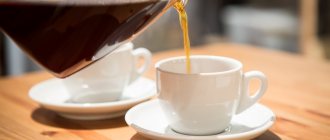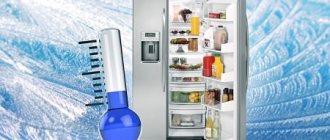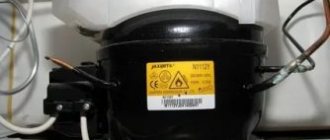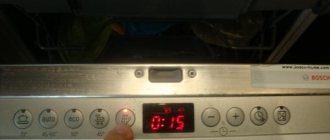History of the carob coffee maker
The prototype of espresso coffee makers was a compression-type machine created by the Frenchman Edouard Loisel de Santé in the 19th century. In 1901, Italian engineer Luigi Bezzera received a patent for a coffee machine that very quickly prepared rich and strong coffee.
Bezzera did not engage in production and in 1903 sold his patent to industrialist Desiderio Pavoni, who 2 years later began producing coffee machines. However, due to a design flaw, the coffee grounds in them overheated, resulting in bitter coffee.
Pavoni's commercial success did not go unnoticed, and soon several more companies began producing coffee machines. Over the next 50 years, large companies were founded that still exist today:
- Simonelli (Italy) – produces medium and high performance espresso machines;
- Faema (Italy);
- Gaggia (Italy) - currently purchased by Philips as part of the Saeco company;
- JURA Elektroapparate AG (Switzerland).
The optimal parameters of a coffee machine for making espresso were determined experimentally:
- pressure in the working chamber is about 9 bar;
- water temperature ranges from 86 to 93 ºС.
Coffee maker Gaggia 1948 goals
The founder of Gaggia, Giovanni Achille Gaggia, managed to create technology that improved the quality of espresso. Gaggia patented the use of a screw piston to force water through pressed coffee powder. Contact with steam was eliminated, and the bitterness that appeared due to high temperature was removed from the taste of espresso. So-called lever (piston) coffee makers can still be found in cafes and bars, although automatic and super-automatic machines are now in service.
In the second half of the 20th century, the dimensions of coffee machines decreased significantly; coffee makers appeared not only for catering establishments, but also for the home. When designing new devices, electric heat exchangers, rotary pumps, and an internally heated cooking chamber were used. The predecessors to modern home espresso machines were released in 1961:
- "Elektra Micro Casa a Leva";
- "La Pavoni Europiccola".
In 1964, the La Pavoni Professional Lever coffee maker, specially designed for home use, went on sale.
History of coffee makers
Optimal indicator
The pressure level in a coffee machine and coffee maker affects the formation of foam, enrichment of aroma, creation of taste, and cooling of the drink.
A pressure gauge reading of 9 bar guarantees good espresso coffee. It serves as the basis for all other coffee recipes. But it took years of work by inventors to arrive at this figure.
The first Italian mechanics
An Italian inventor named Moriondo created a device with a water vapor pressure of 1.5 bar. Patented in 1885, the coffee maker existed for 7 years. Luigi Bezzera improved it and achieved an indicator of 2 bars. But it was not possible to keep it constant. Whatever grain he ground during the cooking process, the taste in each cup was different in strength.
Signor Pavoni came up with the idea of installing a control valve. This helped keep the pressure at the same level. But it was not possible to increase the steam force. The figure did not exceed 2 bar.
Interesting! Spices and seasonings for coffee
Down with manual labor
The optimal pressure of 9 bar was achieved by 1940, when an additional lever was used to pump water. With this invention, Achil Gadzhia's establishment went down in history. The name appeared - coffee machine. The barista served the drinks with thin foam. It has become an indicator of proper espresso.
The manual piston was replaced with an automatic one after 20 years. Italian Carlo Valente used an electric pump. Now, creating the desired steam did not require any effort, and the taste of the coffee drink became better due to the precise brewing time.
Electronics got involved
The massive use of electronics at the end of the 20th century in all areas was also reflected in coffee machines. Inventors create multifunctional devices.
The desired button allows you to select the option of preparing a hot or cold drink. The menu depends on the device model.
Modern carob-type coffee makers
Progress does not stand still; every day new manufacturers and more and more advanced models appear, possessing a set of additional functions:
- cappuccino machine - a device for frothing milk foam;
- platform for heating cups;
- function of pre-wetting coffee powder;
- in coffee machines - a built-in coffee grinder and processor for executing various programs, including recipes for coffee drinks, self-cleaning and descaling procedures.
How does an espresso coffee maker work?
Horn coffee makers get their name from the resemblance of the filter holder to the coffee horn. In these devices, steam or hot water is pressurized through a filter with tiny holes filled with compacted coffee powder. The hot drink is collected in a container placed under the filter.
To prepare coffee drinks with milk, coffee makers are equipped with cappuccino makers - devices for frothing milk into foam. A cappuccino maker is a tube that supplies steam to a container of milk. At the end of the tube there is a plastic nozzle with three holes, designed to intensively froth milk with jets of steam under pressure.
Factors that affect the taste of espresso:
- variety, degree of roasting and grinding of coffee beans;
- temperature of water supplied for extraction;
- the pressure that develops in the working chamber.
Types of carob coffee makers and coffee machines
Based on the operating principle, carob coffee makers are divided into 2 groups:
- steam;
- pump-action
Features of steam coffee machines
Steam coffee makers, or Steam-Espresso, are much cheaper than pump coffee makers, but the quality of the drink differs in strength and taste.
The steam generated as a result of boiling water in the tank, when a pressure reaches 4–5 bar, opens the valve and enters the working chamber (inside the filter holder). Then the steam passes through a compressed tablet of ground coffee, then the condensate flows into a cup placed in advance. The drink may taste bitter because the steam temperature is too high, and due to the low pressure (below 9 bar), the contact of the coffee grounds with the steam lasts quite a long time.
Steam-Espresso example
It is difficult to obtain classic espresso in a steam coffee maker; the result in consistency and taste is closer to lungo, although the caffeine content will be high.
Advantages:
- steam coffee makers are cheaper than pump coffee makers;
- do not create noise during operation;
- The drink turns out to be invigorating.
Flaws:
- Preparing a cup of coffee takes longer than with a pump coffee maker;
- The drink turns out a little watery.
Features of pump coffee makers
Pump-type coffee makers (also called Pump-Espresso) are considered a better option than steam ones. Pump coffee makers are equipped with an electromagnetic pump that drives water through a thermoblock. In the boiler, the water is heated to a temperature no higher than +93 ºС, creating high pressure, which in the filter can reach up to 10, and in some models – up to 15 bar.
Pump-Espresso
Drinks prepared in Pump-Espresso coffee makers are better, and the taste of the coffee beans is revealed more fully.
Advantages:
- the drink is rich, without particles of grounds;
- a lush coffee foam (cream) is formed;
- preparing a cup of coffee takes 20-30 seconds;
- the taste lacks sourness and bitterness.
Flaws:
- the pump pump is noisy;
- quite high price.
About pressure in different types
Drip brewing
If we take into account the stages of development of coffee makers, then the operating principle of the drip variety remains at the level of the 19th century. The water boils in the boiler, drops of condensate flow through the brewing unit into the prepared cup.
Expert opinion
Vadim Kudryavtsev
Coffee expert, professional barista and simply in love with this aromatic drink.
Ask the barista a question
Brewing occurs not with boiling water, but with liquid cooled by condensation at a temperature of 90-92 degrees. This way, more natural nutrients are preserved. The unit maintains pressure at 1.5 bar.
Only Americano is prepared in drip devices. For cooking, use medium grind grains
Universal percolators
In percolators, steam from boiling water travels up a tube, onto the coffee powder, and then onto the filter. Previously, to circulate water, the vessel was heated with coal, now - with electric heating elements.
The finished drink flows into a container and is poured into cups. Pressure 1.5 bar, water temperature 100 degrees.
The percolator has one container for water and the finished drink. This means it is bitter due to constant brewing. The versatility of the device lies in the ability to make a regular kettle out of it. To do this, you need to remove the percolation system.
Moke - geyser installation for brewing coffee
In this device, the liquid is heated on a gas burner and boils at the bottom of the device. Boiled water (100 degrees) rises and immediately passes through the filter funnel with coffee. Steam pressure 1.3 - 1.5 bar.
The finished brewed product ends up at the top of the installation. It pours into cups through the spout.
Now let's talk about what the grind size affects. To prevent excess substances from getting into the finished product, it is important to use a medium grind or a little finer for this brewing method.
Options for espresso
To make espresso you need to buy a steam or pump coffee maker.
In steam water, it boils in 2 minutes, turns into steam and enters the horn filter under a pressure of 5 bar. The liquid temperature is 100 degrees, which is a minus. Boiling water “pulls out” the bitterness from the grains.
Expert opinion
Vadim Kudryavtsev
Coffee expert, professional barista and simply in love with this aromatic drink.
Ask the barista a question
The most accurate espresso is made by pump-action models, where the water does not boil, but only heats up to 90 degrees.
The pump applies a pressure of 7 bar to a compacted coffee tablet. Both types of coffee makers create milk foam when brewing cappuccino. There is a special steam pipe for this.
Coffee machines work similarly. The pressure is not raised to 15 bar, since the standard for espresso is 9 bar.
Carob varieties
Carob coffee machines include semi-automatic and automatic coffee machines. This is a common type of espresso coffee maker. The grains in the required quantity are placed in the horn, which is why the design got its name. Otherwise the horn is called a holder.
Interesting! Why can coffee sour?
In pump-action carob machines, the water reaches a temperature of a maximum of 95 degrees. Using a pump that creates a pressure of 8-10 bar, the liquid is pushed into the horn. In steam devices, the pressure ranges from 4 to 5 bar, and the water boils.
To preserve the taste and aroma of the drink, it is preferable to take a pump-action carob model.
The advantage of capsule types
If you don't want to bother with beans, buy a good capsule coffee machine. The name means that the unit operates on capsules. A person takes pressed coffee (capsule) and puts it in the desired compartment. One finger press and the process begins.
A hollow needle pierces a coffee capsule. Water (100 degrees) is supplied through the needle using a pump under a pressure of 5-15 bar. After passing through the coffee powder, the liquid is poured into the cup.
The drink options depend on what capsules we use. This could be tea or drinks with cream or milk.
Do you think the coffee from a regular coffee machine is different from a capsule coffee machine?
Not really
Combination devices
If you take a combination coffee maker for use, you can catch two birds with one stone. The main advantage is saving kitchen space. The disadvantages include a lot of effort to care for the nodes, because there are twice as many of them.
When combined, the drip design is combined with espresso. This unit makes a choice of espresso and Americano.
Another design combines a geyser with espresso. Two prescriptions are also issued upon request. The pressure in the machines ranges from 5 to 15 bar. Water temperature is from 90 to 100 degrees. The indicators depend on the selected type of coffee.
Both units are convenient when using capsules and tablets (pods). If desired, you can get a cappuccino.
Automation for ease
The development of modern technology and electronics has led to the creation of fully automated coffee machines. A person is required to load grains and water into containers. The only effort is pressing the desired button.
The devices have special panels with options for ready-made drinks. Among the possible types:
- milk lattes and cappuccinos;
- strong with less ristretto volume;
- voluminous due to lunge water;
- capsule hot chocolate.
Most of these recipes use espresso as a base. Only the proportions of milk, cream, water change and the formation of foam is controlled.
The creation of the recipes listed depends on the water vapor pressure in the coffee machine. The minimum indicator is 4 bars, the maximum is 20.
Electric Turks
Don’t forget about the simplest devices. This is a Turk - a dish in the form of a small jug with a spout for easy pouring of the finished drink. The Arabs call it cezwa. Traditionally, they are made of copper and placed on an open fire, after pouring water and adding ground coffee. This is an old, proven method in which coffee was prepared in the east.
An electric Turk can be considered the same simple coffee maker. A portion of coffee is also poured into it and water is poured in, which is brought to a boil, but using heating elements. We are not talking about pressure here. And the water heats up to 100 degrees.
Low pressure pods
Coffee makers that are used to prepare portions in ready-made bags are called pod coffee makers. The operating principle is similar to horn devices. In steam models, a pod filter is additionally used.
Hot water at a temperature of 100 degrees passes through a bag of ground coffee. The aroma is guaranteed, but foam does not form, since the water pressure is only 3-4 bar.
Interesting! How many cups of coffee will be produced from 1 kg of beans?
How to choose a carob coffee maker for your home
Steam or pump? – this is the main question that you need to decide for yourself when choosing a carob coffee machine for your home.
Important parameters:
- What material are the body and horn made of: metal is stronger and will last longer, the product will not smell like plastic. The coffee powder in such a coffee maker warms up better, resulting in a richer drink.
- What additional options is the device equipped with, for example:
- control of pressure and temperature, water level in the tank;
- timer;
- number of cones, presence of measuring spoons (different in volume, for 1 or 2 servings) and distemper included;
- the presence of several filters for preparing 1 or 2 servings at once, for using pods;
- heated platform for cups;
- possibility of simultaneous preparation of coffee and milk froth;
- blocking of inclusion in the absence of water in the tank or compressed tablet in the horn;
- auto shut-off function if water runs out;
- energy saving mode.
The best carob coffee makers with pump
A pump espresso machine is a device in which water of the appropriate temperature under pressure created by a pump is supplied into a container. As a result of applying suitable pressure (approximately 9-11 bar, the pump is capable of producing up to 15 bar), the coffee from the coffee machine has a characteristic light brown foam (creama). As you understand, in such coffee makers the water is pumped, and this has a disadvantage - the pressure is not uniform. But if you need a coffee maker for the office or home, you won’t even notice it and will still be in the black, since devices with a pump are usually cheaper.
1
Lelit PL41EM price/quality
Rating:5.0
- for ground coffee and pods
- pressure 15 bar
- working pressure adjustment
- making cappuccino
- simultaneous dispensing for 2 cups
Average price: RUB 30,961
The reliable semi-professional carob coffee maker Lelit PL41EM with a power of 1050 W allows you to prepare strong espresso. The case is completely made of stainless steel. Designed for preparing coffee drinks of the highest quality. The spacious water compartment holds 2 liters of water. The horn is brass, wide, professional. The boiler is also brass!
The coffee maker has the function of simultaneously preparing 2 cups of coffee. It has the characteristics of a filter coffee machine, allowing the user to brew the perfect black coffee with optimal intensity. At the same time, it is an espresso machine that allows you to prepare delicate milk coffee with lush foam (cappuccino or latte). This effect can be achieved thanks to the built-in professional hinged cappuccino maker.
Thanks to the large boiler, the steam produced is much greater than that of other home coffee makers.
Peculiarities:
- maximum pressure 15 bar;
- no auto shutdown;
- there is a pressure gauge. Why? You can use the readings as a guide and determine whether you compacted the coffee tablet well. It’s good if the coffee goes between 8 and 12 bar;
- water capacity: 2.7 l;
- no anti-drip system;
- ready time 3 minutes.
2
Gaggia Viva De Luxe
Rating:4.9
- for ground coffee and pods
- pressure 15 bar
- water portion adjustment
- self-cleaning descaling
- making cappuccino
Average price: 18,000 rub.
The Gaggia Viva De Luxe coffee machine with a power of 1025 W is equipped with a professional filter, a cappuccino system and a cup warming function. It allows you to prepare two coffees at the same time. The Gaggia Viva De Luxe espresso machine is compact and has an interesting design. The device has a professional adapter for a cream filter, which allows you to prepare coffee from ground beans, preserving its intense taste and aroma. In addition to traditional espresso, the user can also make a latte. Dairy lovers can make their own delicious, creamy cappuccino using the nozzle that froths milk under pressure.
Peculiarities:
- device weight 4.2 kg;
- there is a cup heating function;
- There is an adjustment of the portions of hot water.
3
Delonghi ECP 35.31
Rating:4.8
- for ground coffee and pods
- pressure 15 bar
- making cappuccino
- shutdown when not in use
- simultaneous dispensing for 2 cups
Average price: RUB 14,553
High pressure coffee maker for home ECP 35.31. equipped with three separate filters that allow you to brew both ground coffee and coffee in ESE capsules. The Crema filter provides a fine and dense foam, ideal for cappuccino. Metal filters with double bottom.
The De'Longhi espresso machine has been made from noble materials of the highest quality, which ensures the longevity of the machine. The horn is externally made of steel, but the filling of the horn is plastic. At the same time, thanks to the matte finish, the coffee machine looks modern, stylish and looks great on the countertop of any kitchen.
The manufacturer has equipped the coffee machine with an innovative and intuitive cappuccino making system, which, using a special nozzle, whips milk, turning it into fluffy and tasty foam. It is possible to regulate the intensity of steam supply.
Thanks to the steel boiler and two built-in thermostats, the coffee completely retains its aromatic, characteristic taste and temperature.
Peculiarities:
- can prepare latte, cappuccino, espresso, latte macchiato;
- it is possible to prepare coffee in pods;
- no pressure gauge.
4
De'Longhi Dedica EC 685
Rating:4.7
- for ground coffee and pods
- pressure 15 bar
- making cappuccino
- shutdown when not in use
- simultaneous dispensing for 2 cups
Average price: RUB 17,990
If you don't like compromises and only accept Italian coffee, the De'Longhi carob coffee machine will be a good solution for you. She will prepare for you coffee that a real barista would not be ashamed of. De'Longhi can make delicious Italian espresso.
In addition, it is equipped with a cappuccino maker - a special attachment for frothing milk, which forms creamy foam, so you get a delicious cappuccino. If you don't like coffee with milk, just add a drop of milk and you will enjoy an Italian macchiato. The set includes three different filters (for one coffee, two coffees and for bags), depending on how many cups of drink you want to prepare.
The coffee machine also has a very functional option for preparing two cups of coffee at the same time. Users are happy with their purchase. They especially appreciate the aromatic and deep taste of coffee. The milk frothing function is also highly valued.
Peculiarities:
- milk frothing function;
- stylish design;
- There is a descaling indicator.
5
Delonghi ECO 311
Rating:4.6
- for ground coffee and pods
- pressure 15 bar
- making cappuccino
- shutdown when not in use
- simultaneous dispensing for 2 cups
Average price: RUB 14,124
The Delonghi ECO 311 is a manual espresso machine with a power of 1100 W. The device has a 1.4-liter water tank equipped with two separate filters for brewing ground coffee, such as espresso and single-serve coffee bags. The machine has a manual nozzle responsible for supplying hot water and frothing milk under a pressure of 15 bar. The device dispenses boiled water using a special pump. For the machine to dispense coffee, the user must first grind it. Thus, water penetrates between the coffee particles, providing the full taste and aroma of the prepared drinks. In addition, the milk frother allows you to prepare cappuccino with delicious foam. After brewing, remove any remaining grounds from the cone.
Peculiarities:
- auto shut-off function;
- it is possible to prepare latte, cappuccino, espresso, latte macchiato;
- passive heating of cups.
6
Garlyn L70 with automatic cappuccino maker
Rating:4.5
- for ground coffee
- pressure 15 bar
- water portion adjustment
- making cappuccino
- simultaneous dispensing for 2 cups
Average price: RUB 14,890
Garlyn L70 is created for demanding coffee lovers. The device's high power of 1450 W means that the coffee maker heats up very quickly. This saves time because we don’t have to wait long for the device to be ready for use.
The 15 bar pressure gives the coffee a taste and aroma that will remind you of your Italian holidays and time spent in a real coffee shop. The most important feature of this coffee maker is the automatic cappuccino maker.
OEM coffee maker.
There are automatic programs for 1 or 2 cups of espresso and cappuccino. It is possible to program the serving size.
The volume of the water tank is 1.4 liters.
The volume of the milk tank is 0.4 liters.
It is possible to pour coffee into tall cups (up to 12 cm).
Peculiarities:
- hot water supply control function;
- no automatic decalcification;
- There is a possibility of automatic preparation of cappuccino.
7
BRAYER BR1100
Rating:4.4
- for ground coffee
- pressure 15 bar
- making cappuccino
- shutdown when not in use
- simultaneous dispensing for 2 cups
Average price: RUB 8,800
The BRAYER BR1100 coffee maker is a good OEM model. A combination of functionality with an interesting and stylish design. It is equipped with a 1.25 liter water tank with the ability to use a filter, a cup warming function and the ability to make cappuccino. An intuitive switch allows you to prepare aromatic coffee in just a few steps. BR1100 is a practical kitchen gadget that looks great in any interior. The device has a stainless steel and plastic body. The appearance of the coffee machine is inspired by the style of the 50s. The milk frothing system transforms the milk's texture into a light, fluffy foam. This is a solution for lovers of creamy cappuccino.
Peculiarities:
- there is no possibility to prepare coffee in pods;
- overheat protection function;
- The set includes a measuring spoon.
8
REDMOND RCM-1512 with automatic cappuccino maker
Rating:4.3
- for ground coffee
- pressure 15 bar
- water portion adjustment
- making cappuccino
- shutdown when not in use
Average price: RUB 16,490
Plastic coffee maker in black color, suitable for kitchens with modern design. There is an automatic cappuccino preparation system.
The horn is made of silumin. Coffee filters with double bottom.
It is possible to program the serving size.
Thanks to its shape, the machine allows the use of tall glasses and mugs, so it is suitable for those who like to enjoy lattes served in tall containers. The downside of the device is that it cannot brew drinks in pods. Therefore, by purchasing this coffee maker, you agree that you will have to wash it after each use.
Peculiarities:
- there is no possibility to cook in pods;
- automatic cappuccino preparation;
- milk tank 0.4 liters.
9
Kitfort KT-722
Rating:4.2
- for ground coffee
- pressure 15 bar
- making cappuccino
- simultaneous dispensing for 2 cups
- metal case
Average price: RUB 9,250
Nice, elegant OEM silver espresso machine at a good price. It has a power of 1050 W and a pressure of 15 bar, so you can save time on preparing a drink. This model has a manual nozzle with steam control, making it easy to prepare cappuccino or latte.
The operation of Kitfort KT-722 does not cause any special problems; the panel is easy to read and equipped with buttons. If desired, you can brew two espressos at once. The machine is a little louder than the BRAYER BR1100, for example, but it definitely deserves its position in this coffee machine ranking.
Peculiarities:
- power cord length 0.9 m;
- easy to use;
- removable water tray with a capacity of 1.5 liters.
Popular coffee makers (model rating)
The rating of carob coffee makers is topped by devices from the brands Delonghi, Vitek, Krups, and Philips. Each model has its own pros and cons. The devices differ in operating principle, water tank volume, power consumption and set of functions.
The leading position is occupied by Delonghi carob coffee makers; they are available both in the middle and in the upper price segment.
Delonghi EC 7. The coffee maker has a relatively low price (RUB 7,500) and is easy to use.
Delonghi EC 7
Characteristics:
- power – 810 W;
- semi-automatic;
- power indicator;
- control of drink strength;
- possibility of making cappuccino.
A more expensive version of the carob coffee maker is Delonghi ECAM22.360 (price - 34,000 rubles).
Delonghi ECAM22.360
Characteristics:
- machine;
- power 1460 W,
- tank volume – 1.8 l;
- possibility to select operating temperature;
- setting the start time;
- presence of a timer;
- control of drink strength.
Another popular coffee maker is VITEK VT-1516 (price - 15,600 rubles).
VITEK VT-1516
Characteristics:
- power – 1060 W;
- semi-automatic for ground grains;
- possibility of adjusting the portion of water;
- the presence of two metal horns;
- There is a water level indicator.
Carob coffee makers care
Carob-type coffee makers are easy to clean:
- easy to remove spent tablet;
- in models equipped with a special filter, you can use coffee in pods, which greatly simplifies the process of preparing the drink and cleaning the filter from grounds;
- The removable tank is very easy to fill with water and wash;
- The drip tray is easy to remove and wash;
- the horn (holder or filter holder) is convenient to insert and easy to remove;
- if even after filtration the water remains hard, you need to descale the device every 2-3 months using a weak solution of citric acid or special products that can be bought in stores.
It is necessary to monitor the condition of the rubber gaskets; the horn should be installed in the holder hermetically and tightly so that it is not torn off by water or steam pressure.
How to use a carob coffee maker (coffee machine)
You will need bean coffee, ground in a burr grinder to medium degree, or commercial fine-ground espresso coffee.
Instructions
- Fill the tank with bottled water with a salt concentration ranging from 75 to 250 mg/l.
- Fill the filter with coffee powder and tamp it with tamper. A measuring spoon holds 7–8 g, exactly for 1 serving, if there is a second, then for 2 servings – 14–16 g.
- Carefully insert the horn into the holding device and turn the handle all the way to the right.
- Start the pre-wetting function, if the coffee maker has one.
- Turn the switch to the “On” position.
- Wait until the indicator light comes on, indicating that the water has warmed up.
- Place the heated cup on the grill covering the tray and turn on the button (or turn the switch) to release the finished drink.
- If you want to prepare milk foam, you need to use the “Steam” function and place a pitcher or a glass of milk under the plastic nozzle of the cappuccino maker. Turn on the cappuccino maker. Use a spoon to add milk foam to the cup of coffee.
- After the cycle ends and the cone has cooled, turn the handle to the left, carefully remove the filter with the wet tablet from it and throw it away. Rinse the equipment with running water, being careful not to leave grains of ground coffee on the edges of the filter and horn.
- If the tray is filled with liquid, you must carefully remove it, pour the contents into the sink and rinse under running water, otherwise mold may appear.
- Unplug the coffee maker or leave it in standby mode if this is not your last cup of coffee for the day.
Malfunctions of carob coffee makers
A semi-automatic or automatic coffee machine is a rather complex device with fine tuning. Repairs will not be cheap, but tampering with the device yourself can cause considerable harm. You should not repair the electrical system unless you have the appropriate training and skills in using instrumentation. Everything related to electronics and heating elements should be left to specialists, especially if the warranty period has not yet expired.
The main thing is to properly and regularly care for the coffee maker, then there will be few malfunctions.
A carob coffee maker, the function of which is only to prepare a drink using ground coffee, is also a serious mechanism. But if adding water, filling and cleaning the horn, emptying the drip tray, and flushing all systems from contaminants is done manually, then you can fix some problems yourself.
Types of coffee makers for home
Espresso coffee makers brew a drink from ground beans under high pressure; a special design allows them to pour coffee raw materials into the coffee maker's horn. There are several types of these household appliances:
- A pump-action coffee maker, which uses a vibration pump, is reliable in operation and economical to maintain. Only the use of such a pump ensures uneven pressure; its rotary type analog rotates the impeller, scooping and supplying water through a hydraulic circuit at a constant speed, due to which the pressure is constant and has a positive effect on the taste of the coffee product. The second version of pumps is more expensive; they are professional. But a coffee machine with a vibration pump is suitable for home use for those who prefer strong expresso.
- Canonical carob coffee makers for home are a compromise option for lovers of Americano; their final product is similar to their geyser counterparts. The drink obtained from them does not differ in strength. The pressure in them can reach up to 9 bar.
- The lever coffee maker belongs to the premium segment and is used by professional baristas. In these home espresso drinks, the pressure is regulated by pressing on a mechanical lever. Thanks to such a special horn for a coffee machine, precise tuning of the process of obtaining an aromatic product is ensured, but it requires the experience and skills of a barista. Lever coffee makers have little automation, which is why they are not in demand.
- Boiler coffee makers are a budget option for a decent coffee machine for the home, which only produces espresso. They operate at low pressure, it can range from 2 to 4 bar, when the water in the metal boiler boils, it enters the coffee maker through the valve.
An important element by which you can determine the best carob-type coffee makers is the heating element. Each type of coffee machine has its own. The quality of the product will depend on it and the pressure of the unit, which is why temperature stability is so important. If the coffee maker does not heat the liquid to the required temperature, then decent coffee will not be produced, despite the experience and professionalism of those using it.
Carob-type coffee makers in the economy segment are equipped with a flow-through thermoblock or a small boiler, but their more expensive analogues already come with a larger boiler or have a heat exchanger built into it.
The pros and cons of each of the heating elements used will help you decide on the choice of coffee maker:
- A large boiler can provide a sufficient amount of water at a certain temperature, and after preparing one cup there will be no additional heating. But it is worth knowing that it will take some time before preparing the first cup, especially if the espresso maker has not been used for a long time.
- The thermoblock cannot provide a constant temperature; changes are possible when using it, but it is capable of supplying hot water instantly without lengthy preheating.
- The low-volume boiler used in home boiler coffee makers is responsible for dispensing a small amount of water, and even a single cup of espresso will require additional heating.
- A heat exchanger is a whole system consisting of tubes through which water circulates; they are compactly located inside the boiler. It takes a long time to heat up, but the output is water at a stable temperature. The initial portion of water is overheated and will need to be drained; this is called “idle spillage”.
Double-lance coffee machines have two boilers, one of which is used for espresso, and the second for steam.
It is not difficult to choose which coffee maker is best for the home, taking into account the characteristics of their types, but for each type there are several models available, but purchasing one of them depends on the desired drink, the design of the device and its versatility.










